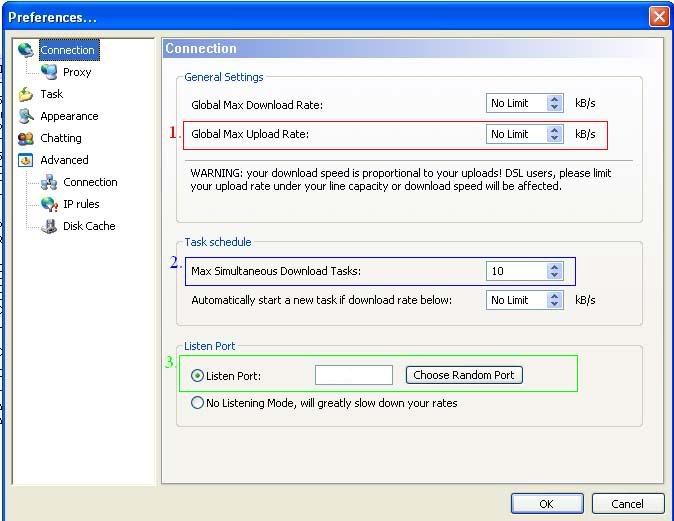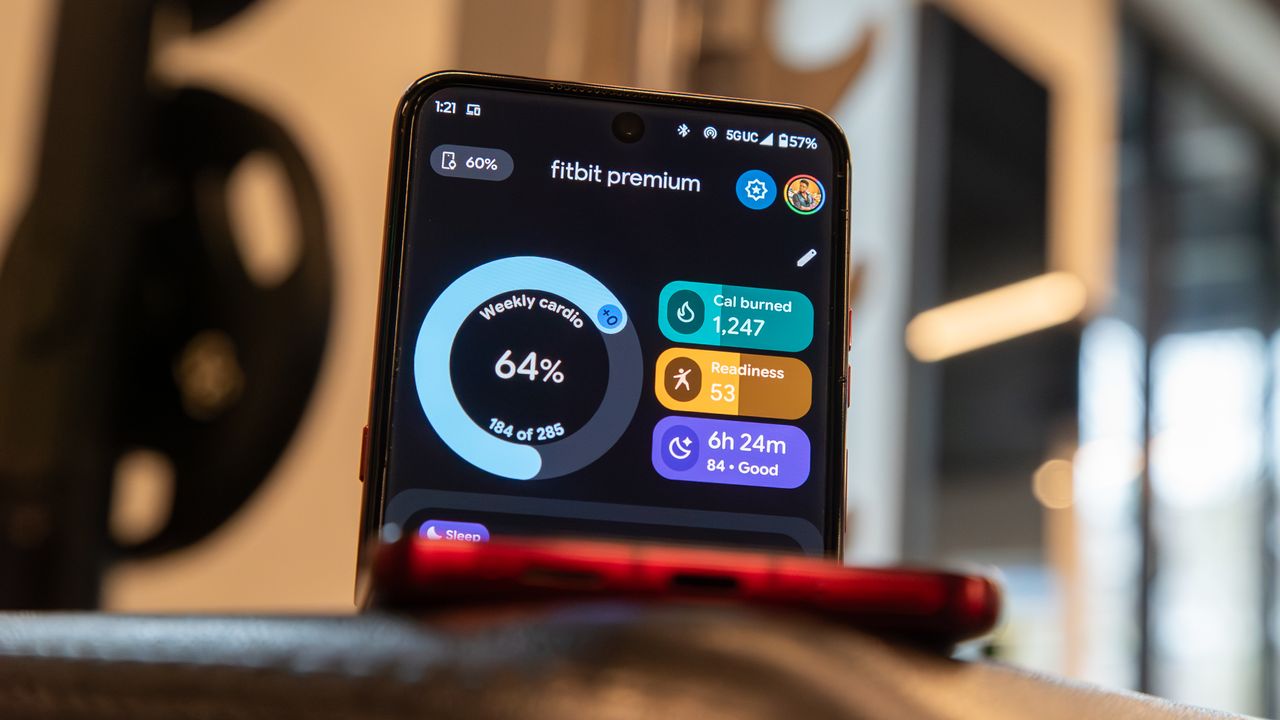This guide only focuses on how to help BitComet users to increase their speeds with the bandwidth they have.
KEY (commonly used phrases in this guide):
- ISP - Internet Service Provider - The company you've purchased your bandwidth from.
- s - Seconds i.e. kB/s means KiloBytes per second.
- FAQ - You may see this pop up around this guide randomly in bold, this is a notification message to users about certain issues.
- Seeder - People who have 100% of that file
- Peer - Includes all the users who are both download and/or seeding the torrent download.
- Tracker(s) - A Bittorrent Tracker is a server which directs uploading and downloading of packets on BitTorrent. It is also, without any extension to the existing protocol, the only major single point of failure as peers require to communicate with it at regular intervals to receive up-to-date information. [Wikipedia].
- Listening Port - The port that other peers connect to Bitcomet on. Read Here for an explanation of what a Port is.
FoReWoRd to all BitTorrent Users:
Before you read my guide, please ensure that you have at least a 256/64 [ADSL or ISDN] connection/plan in place by your ISP. If you're unsure of what plan you're connected to, please phone your ISP.
This Guide may skip around the BitComet client a little, but I will try and allow the steps to follow on within each screen.
STEP 1
First and foremost, before we start jumping into the configuration of maximizing your download speed, we'll need to check your MAX Download/Upload speed (commonly referred to as your Bandwidth). Head here:
www.dslreports.com/speedtest
or to:
www.speedtest.net
1. Locate one of the sites on that page which is in correspondence closest to your location on Earth.
2. Follow their instructions to test your speed, and be sure that your Internet Connection is IDLE during that test, i.e. no Internet activity, except for the use of that test, otherwise it will be inaccurate. Also, this test should be done only on the PC you wish to run BitComet on.
3. The test should come out in units KiloBytes/s, if it comes out in Kilobits/s, then you will need to convert the units of your Bandwidth back into KiloBytes/s. [KB/s]
FAQ1 Here's how you convert between kB/s (kiloBytes per second) & kb/s (kilobits per second): -
1 KB/s is equivalent roughly to 8 Kb/s so in other words: 8x kb/s = x kB/s
E.g. If I obtained a Download speed of 800 kb/s and Upload speed of 512 kb/s. Your Download speed would be: 100 kB/s and your Upload
speed would be: 64 kB/s.
NOTE: As this is an approximate calculation, we need a really close speed indication, so be sure to deduct about 4 kB/s from your
calculated speed values.
So, following on from my example: My real (really close) Download speed would be 96 kB/s and Upload speed would be: 60 kB/s.
FAQ2 An immediate question raised by users would be: Well, yes I actually can get my maximum download/upload speed via HTTP downloads/uploads, how come this isn't the same for torrent downloads? Well, this is simply because the download speeds you get are fully dependent upon the upload speeds given by seeders/peers in your torrent download (this is especially the case for Public Trackers. The most recommended method to maximize the download speed you're obtaining, is to join Private torrent communities (Sometimes also referred to as Private Trackers).
STEP 2:
Part 1
Now, a little mathematics. Using your real upload speed value, multiply that number by 80% or 0.8
Example:
My real upload speed is 12 kB/s <---Multiply this number by 80%
My Calculated upload speed value is: 9 kB/s
Next, open BitComet, click OPTIONS --> Preferences and you should arrive in the below screen:

In Global Max Upload Rate (circled in pink), type in your Calculated upload speed value
The capping of your Global Upload Rate applies to all Cable/xDSL/ISDN users.
Part 2
Within that SAME screen shown above in BitComet, in Max Simultaneous Download Tasks, type in a number between the range of 1-3. To achieve maximum download speeds, use 1.
FAQ 3: High Speed Connection users can have up to 3-5 simultaneous download tasks if they want. But keep in mind, allowing only 1 downloading torrent to be active, maximizes your download capability.
FAQ 4: Try not to run seeding tasks during your downloading of torrents, as this too also lowers upload capability to the torrent you're downloading. In turn, this reduces your download capability.
Part 3
Within that SAME screen shown above in BitComet, in Listen Port --> Click Listen Port checkbox, and in the white rectangular blank box next to it, type in a number preferably in the range 49152 to 65534 IANA c.f.
STEP 3:
Now that you've completed configuring your BitComet Client. We'll need to move onto your PC configurations.
FAQ 5: How do I know if my modem is also a router? Check your Router Manual, or do a google search (Type in the brand & model number) to verify.
A: If you own a router, continue reading. If you do not have a router, but you do use a modem, continue on to B.
You will need to create a static IP for the PC you use for BitComet downloading, then forward your listening port. All the information is available at: How to set up Portforwarding & Static IP
Next, move onto C.
B: If you own a modem (not a router), you may still be able to access your Modem's settings (i.e. By typing in 192.168.2.1 onto your web browser).
Here you can do 2 things:
- If you wish, you can create a static IP for your modem, but whether or not it has an effect, I'm not sure. Static IP instructions are also included at the beginning of theHow to set up Portforwarding & static IP guide.
- Disable the UPnP function: Open BitComet -> Preferences -> Options -> Advanced -> Connection -> UNCLICK "Enable UPnP Port Mapping (XP only)".
If you use Window's SP1 Firewall, please go to ~Type 2~.
~Type 1~
Adding BitComet into exception list of Windows SP2 Firewall:-
Here you have two choices, you can add BitComet fully as a Program itself(1). Or by Port(2).
(1) These are the general steps to add BitComet to the Windows XP SP2 Firewall Exceptions list.
- Click Start, and then click Control Panel.
- Double-click Windows Firewall (or click Security Center and then Windows Firewall).
- In the Windows Firewall control panel, click the Exceptions tab.
- Click Add Program.
- You will now see a list of installed programs.
- Select the BitComet program and click OK to add the program (see NOTE if the program is not listed).
- Click OK to close the Windows Firewall control panel.
- Restart the computer to enable these choices.
NOTE: If you didn't see the name of a program you were attempting to add above, click the Browse button (Locate BitComet.exe). By default, we'll click My Computer. Double Click on Local Disk (C:). Navigate to C:\Program Files\Bitcomet and select Bitcomet.exe
- Click Start, and then click Control Panel.
- Double-click Windows Firewall (or click Security Center and then Windows Firewall). In the Windows Firewall control panel, click the Exceptions tab.
- Click Add Port. Enter the Name as BitComet and the Port should be the same as the listening Port using in BitComet. Select the TCP option and click OK to add the port.
- OPTIONAL STEP: For users who keep getting "DHT not Connected", add in the UDP Option as well. Use the same listening port as TCP.
- Click OK to close the Windows Firewall control panel.
[Credits to Dragosani of P2P Forums for info below]
Windows XP SP1 Firewall
Go to Start > Settings > Control Panel > Network and Internet Connections > Network Connections.
Right click the Local Area Connection and choose Properties (if there is more than one use the one that says Connected underneath). Then click the Advanced tab.
Click the Settings button at the bottom. In the Advanced Settings window, on the Services tab, click the Add button and enter the following information (you need to make 2 rules, one for TCP and one for UDP):
Description of service: BitComet TCP
Name or IP address: localhost
External Port: enter your 'Listen Port'
Internal Port: enter your 'Listen Port'
Select TCP
Click OK
Click the Add button again and enter the following information:
Description of service: BitComet UDP
Name or IP address: localhost
External Port: enter your 'Listen Port'
Internal Port: enter your 'Listen Port'
Select UDP
Click OK
Software Firewalls
As for software firewalls such as Sygate, Outpost, Kapersky Firewall, etc. be sure to add BitComet's TCP & UDP Ports. If users have added BitComet into their firewalls, and would like to type out the steps with screenshots (if possible), please PM any of the forum staff about it, and it'll be added into this guide. Credits & Permission will be posted along with it.
FAQ 6: How come I need to configure my Firewall? I'm still downloading & uploading. Head here for info
Step 4
FAQ 7:Why is my *browsing so slow while I'm leeching? Your download speed is always finite. If you are a peer in a fast torrent it will almost certainly saturate your download bandwidth, and your browsing will suffer. It would be best to limit your maximum if not individual download rates for your torrent needs[/url].
*Browsing may include Online Gaming, Instant Messaging, etc.
Finally, if you really wish to attain maximum speeds with your torrents, I would strongly encourage you to join Private Torrent communities like Moonlight, etc. With this, I conclude this BitComet Speed Guide. I will update it whenever new tips arrive.
I hope this really answers the most 'newbie' question of "How can I make my downloads go faster". You should all know that there aren't magical tricks, nor are there any external accelerators that can increase your download speed.
Weird Question Asked in our forum once was: If I had a 256/64 connection, can I get say 60 KB/s download speeds? Well, the answer is no, you can't pour a liter of milk from a bottle that only contain half a liter.

































